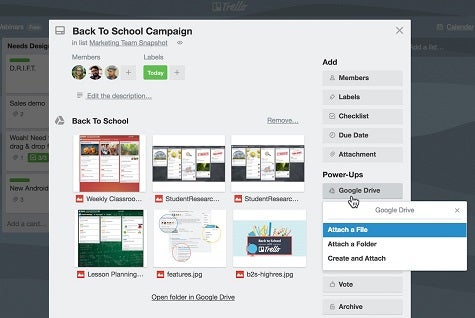Although professional project managers might look askance at either Slack or Trello as tools for managing complex projects, the fact remains end users are organizing tasks within projects using these tools every day the week.
Technically, Slack isn’t a project management tool at all. It’s a collaboration platform provided as a cloud service. Like most collaboration platforms, Slack can be bent to serve the project management needs of a small team by, for example, creating a team that is granted access to all the same notifications.
Trello, meanwhile, is a software-as-a-service (SaaS) application designed specifically to provide a lightweight approach to organizing tasks. There are, of course, third-party applications that take advantage of the application programming interface (APIs) Slack exposes to add additional project management functionality. However, it’s also worth noting that Trello has employed those same APIs to integrate with Slack as well, so in many instances, Trello can easily be employed as an extension of Slack, and vice versa.
What are the Similarities & Differences between Trello and Slack?
While both Trello and Slack manifest themselves as SaaS applications, Trello includes specific project tracking tools such as creating agendas for meetings and prioritizing one idea over another. Slack can play a significant role in facilitating conversations between members of a team before, during and after a meeting. But in terms of managing any given project, Trello provides a much more purpose-built user experience.
Cost
Trello Pricing
Trello is available via a freemium pricing model. Pricing for a Business Class edition starts at $9.99/user/month for an annual contract. There is also an Enterprise Class edition, priced at $20.83/user/month for an annual contract.
Slack Pricing
Slack is available for free up to 10,000 searchable messages/month and 10 apps or service integrations. A Standard Edition of Slack is available for $6.67/user/month for unlimited searchable message archive and unlimited apps and service integrations. There’s also a $12.50/user/month option to gain access to SAML-based single sign-on capability and a 99.99 percent guaranteed uptime service level agreement.
Ease of Use
As SaaS applications, Slack and Trello are designed to be extremely accessible. But in terms of a user interface designed for managing projects, Trello as a purpose-built application is going to have more appeal for project managers.
Slack User Interface

Trello User Interface
Implementation
Implementation times for both Slack and Trello are measured in minutes.
Customization
The Board metaphor that Trello provides to make it easier to navigate projects is highly customizable.
On the other hand, Slack is a highly extensible communications application. As such, Slack, with some programming effort, can function as a customized project management application.
Integrations
Thanks to a set of open application programming interfaces (APIs), Slack is one of the most extensible collaboration applications ever deployed in the cloud. But there are only a handful of Slack integrations that are specific to project management use cases. Trello is now owned by Atlassian, which has spent most of the last year extending the reach of Trello into a variety of vertical industry use cases.
Customer Support
Slack provides support to customers that license its software on a monthly basis. Trello is supported by Atlassian which, in addition to providing support, has made significant strides in building a project management community around Trello.
Features & Add-ons
There are now over 300 different add-ons for Trello. In comparison, there may be thousands of Slack add-ons, but only a handful of those add-ons and extensions, including Trello itself, are focused on project management.
How to decide which is Best for Your Situation
Organizations that have embraced Slack almost invariably try to extend the team collaboration platform to address multiple use cases, including project management, under the assumption that a collaboration application that is well liked with end users will reduce many of the hurdles associated with getting those same users to log into a separate project management application. But unless those organizations buy an add-on software specifically designed to manage tasks within the context of a purpose-built application, employing any collaboration application as an alternative to a purpose-built project management application will be a challenge.
In fact, organizations should be careful that they don’t rely too much on a customized application developed by an internal Slack enthusiast only to discover that person, months later, has left the company with no one knowing how to continue to support and update that application.




